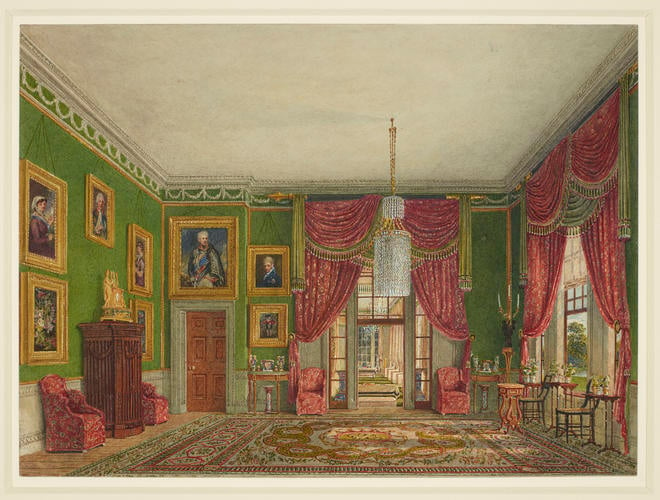Charles Wild (1781-1835)
Frogmore House: The Green Pavilion c. 1817
Watercolour and bodycolour over pencil | 20.0 x 27.4 cm (sheet of paper) | RCIN 922121
-
A watercolour view of the Green Pavilion at Frogmore House, with the door on the far wall opened into the loggia. Prepared for one of the plates in William Henry Pyne's History of the Royal Residences (1816-1819). Engraved by D. Havell, the print published 1.6.1817.
Pyne's History of the Royal Residences was a three-volume publication which encompassed a number of royal residences, including Windsor Castle (vol. 1) and Buckingham House (vol. 2), presenting 100 hand-coloured engravings of exteriors and interiors accompanied by descriptive texts. The 100 watercolours which were engraved for the publication survive in the Royal Library; these watercolours are exactly the size of the image on the printed plates, and may perhaps have been intended as colour guides for the artists responsible for hand-painting the monochrome prints.
Catalogue entry adapted from George III & Queen Charlotte: Patronage, Collecting and Court Taste (London, 2004):
The Queen’s earliest additions to the late seventeenth-century house at Frogmore, completed by mid-1795, were the two single-storey pavilions linked by a colonnade stretching across the garden front. The Green Pavilion was at the northern end of the colonnade; the room decorated with flower paintings by Mary Moser was at the southern end. In this view, the French windows leading into the Mary Moser room are visible at the end of the colonnade. The windows at right are wide open, to reveal the new landscape garden.
Many of the family portraits shown here are no longer in the Royal Collection: this applies to Beechey’s charming painting of Princess Augusta - later the owner of Frogmore - holding a spindle (at left). It also applies to the flower piece to the lower left, to Gainsborough Dupont’s George III high to the left, to the version of Beechey’s portrait of Princess Elizabeth to his right, to the overdoor of Prince Ernest (again after a Beechey model) and the small head of George IV. Wright’s painting of the Queen’s sea passage to England in 1762 (403525) appears partially hidden to the right; Stroehling’s Duke of Sussex hangs to the right of the door (403023 or a version of this).
Other items recorded by Pyne in this room include the pair of side tables shown at either side of the door into the colonnade, their tops decorated with flowers, by Princess Elizabeth.Provenance
Probably acquired by George IV
-
Creator(s)
Acquirer(s)
-
Medium and techniques
Watercolour and bodycolour over pencil
Measurements
20.0 x 27.4 cm (sheet of paper)
Other number(s)
RL 22121Alternative title(s)
The Green Pavilion, Frogmore.








